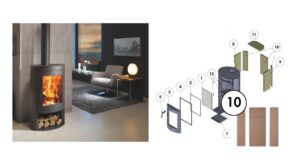
Although we enjoy the warmth of the fireplace, the odors can be unpleasant. With simple tricks like vinegar, salt, or baking soda, you can keep your home fresh and cozy.

Installing wood stove pipes is like mapping the path for heat to reach every corner of your home. It’s not just a technical issue; it’s a process that connects the crackling sound of firewood with the warmth of your home.
At Panadero, where every stove is crafted with the utmost care and dedication, we know that a proper pipe installation is the key to a worry-free winter.
Today, I’ll tell you how to do it right, with practical advice and an expert approach that will make your stove shine like never before.
A poorly placed pipe is like a badly sealed window: it lets heat escape and takes away your home’s comfort.
A proper installation ensures that smoke flows smoothly, preventing build-ups, bad odors, or, even worse, safety hazards.
Additionally, a well-designed pipe system improves the chimney draft, making the stove more efficient and distributing heat better.
To achieve this, keep in mind these 4 essential keys:
✔️ Use rigid metal pipes and never flexible ones, as they can accumulate soot and reduce the stove’s performance.
✔️ At Panadero, we recommend double-wall pipes for exterior outlets, as they prevent condensation and keep the draft clean.
✔️ Investing in quality materials means peace of mind and long-term durability.
✔️ The length of the pipes matters more than you think.
✔️ To ensure good draft, the vertical section should be at least 3 meters long.
✔️ Avoid elbows and long horizontal sections, as they make it harder for smoke to exit and promote residue accumulation.
???? Think of smoke as a traveler: it needs a straight, unobstructed path to reach its destination without issues.
✔️ The smoke outlet should be above the roof ridge, preventing the wind from pushing smoke back inside.
✔️ Additionally, use an anti-downdraft chimney cap, which protects the chimney from rain and prevents uncontrolled spark emissions.
⚡ A small detail that makes a big difference in safety and performance.
✔️ Safety is a priority.
✔️ Keep pipes away from flammable materials, such as wood or curtains.
✔️ Use refractory sealant at the joints to prevent smoke leaks.
⚠️ A poorly sealed pipe can be a silent danger, and at Panadero, we want you to enjoy your stove with total confidence.

✔️ Sweeping the chimney at least once a year is the key to maintaining maximum efficiency and safety.
✔️ Soot buildup not only reduces performance but can also be a fire hazard.
✔️ Proper maintenance, combined with a well-executed installation, ensures that your stove will be with you for many winters.
???? Like everything you take care of with love, it will last longer and work better.
Installing wood stove pipes is a key decision to enjoy a worry-free winter.
With the right materials, a well-thought-out layout, and constant maintenance, your stove will not only heat your home but also make winter an enjoyable experience.
At Panadero, where every detail counts, we want you to experience winter as it should be.
???? Visit our online store at ???? www.panadero.com
???? Do you have any questions? Write to us! With soot-covered hands and fire in our souls, we’ll help you find the stove of your dreams.

Although we enjoy the warmth of the fireplace, the odors can be unpleasant. With simple tricks like vinegar, salt, or baking soda, you can keep your home fresh and cozy.

How to avoid dust in the house when using a wood stove: tips and tricks for a clean and healthy home

Learn how to remove mould from your wood for use by following the steps in this article.

All you need to know: what it is, uses and benefits of wood stoves
To provide the best experiences, we use technologies like cookies to store and/or access device information. Consenting to these technologies will allow us to process data such as browsing behavior or unique IDs on this site. Not consenting or withdrawing consent, may adversely affect certain features and functions.